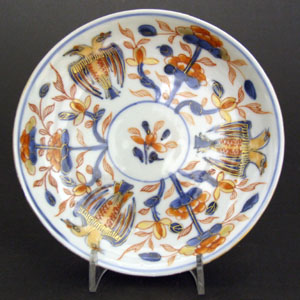
KANGXI 1662 – 1722 Chinese Export Porcelain
A Chinese Export Porcelain Beaker and Saucer, Late Kangxi Period c.1710 – 1720. Probably Made for the Ordem de Santo Agostinho (The Order of Saint Augustine), Decorated Using the Imari Palette with Double Headed Eagles Among Flowering Plants.
SOLD
- Condition
- Very good, the saucer has two minute glaze frits c.1 or 2mm, some unevenness in the potting of the rim.
- Size
- Diameter of the Saucer : 13.8 cm (5 1/2 inches).
- Provenance
- N/A
- Stock number
- 22407
- References
- For a very similar Chinese Export Porcelain beaker described as a libation cup see : Chinese Porcelain at The Time Of Empire (Nuno de Castro, ACD Editions, 2007. ISBN 978-9728855-39-0) page 354.
Information
Chinese Imari Porcelain :
Imari Porcelain is the European collectors` name for a type of Japanese Porcelain made in the town of Arita, in the former Hizen Province, north western Kyūshū, and exported via the port of Imari, specifically for the European Export trade. Imari was simply the trans-shipment port for Arita wares, no porcelain was made there. The kilns at Arita formed the heart of the Japanese Porcelain industry, which developed in the early 17th century, after the white kaolin clay was discovered in 1616 by abducted Korean potter Yi Sam Pyeong (1579-1655). Although Imari originating in Japan the tern is used to describe a whole range of ceramics from all over the world, they are all linked by their palette of blue, red and gold. The Chinese Porcelain industry based at Jingdezhen made what they thought they could sell, like most potters in the 18th century they had no compunction in copying what was made elsewhere. It made perfect commercial sense, it was much safer to make something that had already been tried and tested on the market. The Chinese copied the Japanese Imari palette of underglaze cobalt blue enlivened with overglaze iron red and gilding, they also copied the Japanese patterns that used Imari colours, sometimes they shapes of vessels were copied too. Porcelain decorated with the Imari colour scheme would have looked very rich and opulent in flickering candle light on 18th century Western walnut and mahogany furniture. Indeed the colour scheme became so popular in the West during the 18th century that it was copied by most European Porcelain factories.



